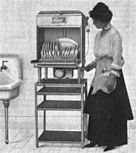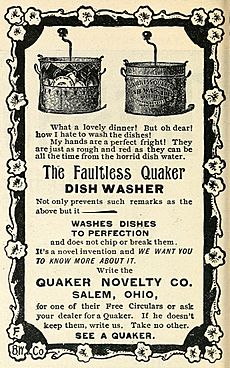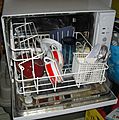Dishwasher facts for kids
A dishwasher is a machine that automatically cleans your dishes, cookware, and cutlery (like forks and spoons). Unlike washing dishes by hand, which needs a lot of scrubbing, a dishwasher cleans by spraying hot water, usually between 45 and 75 degrees Celsius (113 and 167 degrees Fahrenheit), onto the items. It uses lower temperatures for delicate things.
Contents
The History of Dishwashers
People have been trying to make dishwashing easier for a long time! The very first machine designed to wash dishes was patented in 1850 in the United States by Joel Houghton. This early machine was made of wood and had to be cranked by hand to spray water on the dishes. But it was slow and didn't work very well.
Another similar machine was patented in 1865 by L.A. Alexander. It also had a hand-cranked system to hold the dishes. However, neither of these early inventions became popular. Some people think this was because, back then, people valued the hard work put into housework, rather than finding easier ways to do chores.
Josephine Cochrane's Smart Idea
The most successful hand-powered dishwasher was invented in 1886 by Josephine Cochrane. She worked with a mechanic named George Butters in her tool shed in Shelbyville, Illinois. Josephine was a wealthy lady who was tired of her servants breaking her expensive china dishes while washing them by hand. She wanted a machine that would clean her dishes safely.
Her invention was shown at the 1893 World's Fair in Chicago. It was first called "Lavadora" but then changed to "Lavaplatos" because another machine already had the first name.
Electric Dishwashers Become a Reality
The first dishwasher for homes that used an electric motor was invented and made by a company called Miele in Germany in 1929.
In the United Kingdom, William Howard Livens invented a small, non-electric dishwasher in 1924 that was good for homes. It was the first dishwasher to have many features we see today, like a door for loading, a wire rack for dishes, and a spinning sprayer. He added drying parts to his design in 1940. This machine came out when more homes were getting permanent plumbing and running water.
Even with these inventions, dishwashers didn't become very popular until after World War II, in the 1950s. At first, only wealthy families could afford them. Dishwashers were sold as separate machines or portable units. But as kitchens started having continuous countertops and standard-sized cabinets, dishwashers began to be made in standard sizes. This allowed them to fit neatly under the kitchen counter, just like other kitchen appliances.
By the 1970s, dishwashers were common in homes across North America and Western Europe. By 2012, more than 75% of homes in the United States and Germany had a dishwasher!
Saving Energy and Water
In the late 1990s, companies started adding new energy-saving features to dishwashers. One cool feature was "soil sensors." These are like tiny computers inside the dishwasher that can tell how much food is coming off the dishes. When the sensor detects that no more food particles are being washed off, it knows the dishes are clean.
This sensor works with another smart feature: variable washing time. If your dishes are very dirty, the dishwasher will run longer. If they are only a little dirty, it will run for a shorter time. This helps the dishwasher save energy and water because it only runs for as long as it needs to.
How a Dishwasher Cleans Dishes
A dishwasher works by mixing water with special dishwasher detergent (soap). This soapy water is then pumped to one or more spinning sprayers, which blast the dishes clean. The water and soap mixture is often reused to save water and energy.
Here's how the process usually works:
- Pre-rinse: Sometimes, the dishwasher will do a quick rinse first, which might or might not use soap. This helps get rid of bigger food bits. The dirty water is then drained away.
- Main Wash: Next, fresh water and detergent are used for the main wash cycle.
- Rinse Cycles: Once the main wash is done, the water is drained. Then, more hot water comes into the tub through a special valve, and the rinse cycles begin.
- Drying: After the rinsing is finished, the water is drained again, and the dishes are dried using different methods. Often, a special liquid called a rinse-aid is used. This chemical helps water slide off the dishes easily, preventing water spots, especially if you have hard water.
Besides dishwashers for homes, there are also bigger, industrial dishwashers. These are used in places like hotels and restaurants where many dishes need to be cleaned quickly. These machines wash at higher temperatures, usually between 65 and 71 degrees Celsius (149 and 160 degrees Fahrenheit). They make sure dishes are super clean and safe by using a very hot "final rinse" (around 82 degrees Celsius or 180 degrees Fahrenheit) or by using a special chemical cleaner.
Images for kids
See also
 In Spanish: Lavavajillas para niños
In Spanish: Lavavajillas para niños










